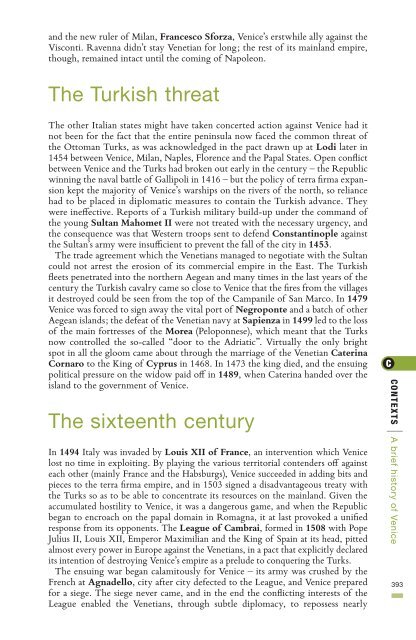You also want an ePaper? Increase the reach of your titles
YUMPU automatically turns print PDFs into web optimized ePapers that Google loves.
<strong>and</strong> <strong>the</strong> new ruler of Milan, Francesco Sforza, <strong>Venice</strong>’s erstwhile ally against <strong>the</strong><br />
Visconti. Ravenna didn’t stay Venetian for long; <strong>the</strong> rest of its mainl<strong>and</strong> empire,<br />
though, remained intact until <strong>the</strong> coming of Napoleon.<br />
<strong>The</strong> Turkish threat<br />
<strong>The</strong> o<strong>the</strong>r Italian states might have taken concerted action against <strong>Venice</strong> had it<br />
not been for <strong>the</strong> fact that <strong>the</strong> entire peninsula now faced <strong>the</strong> common threat of<br />
<strong>the</strong> Ot<strong>to</strong>man Turks, as was acknowledged in <strong>the</strong> pact drawn up at Lodi later in<br />
1454 between <strong>Venice</strong>, Milan, Naples, Florence <strong>and</strong> <strong>the</strong> Papal States. Open conflict<br />
between <strong>Venice</strong> <strong>and</strong> <strong>the</strong> Turks had broken out early in <strong>the</strong> century – <strong>the</strong> Republic<br />
winning <strong>the</strong> naval battle of Gallipoli in 1416 – but <strong>the</strong> policy of terra firma expansion<br />
kept <strong>the</strong> majority of <strong>Venice</strong>’s warships on <strong>the</strong> rivers of <strong>the</strong> north, so reliance<br />
had <strong>to</strong> be placed in diplomatic measures <strong>to</strong> contain <strong>the</strong> Turkish advance. <strong>The</strong>y<br />
were ineffective. Reports of a Turkish military build-up under <strong>the</strong> comm<strong>and</strong> of<br />
<strong>the</strong> young Sultan Mahomet II were not treated with <strong>the</strong> necessary urgency, <strong>and</strong><br />
<strong>the</strong> consequence was that Western troops sent <strong>to</strong> defend Constantinople against<br />
<strong>the</strong> Sultan’s army were insufficient <strong>to</strong> prevent <strong>the</strong> fall of <strong>the</strong> city in 1453.<br />
<strong>The</strong> trade agreement which <strong>the</strong> Venetians managed <strong>to</strong> negotiate with <strong>the</strong> Sultan<br />
could not arrest <strong>the</strong> erosion of its commercial empire in <strong>the</strong> East. <strong>The</strong> Turkish<br />
fleets penetrated in<strong>to</strong> <strong>the</strong> nor<strong>the</strong>rn Aegean <strong>and</strong> many times in <strong>the</strong> last years of <strong>the</strong><br />
century <strong>the</strong> Turkish cavalry came so close <strong>to</strong> <strong>Venice</strong> that <strong>the</strong> fires from <strong>the</strong> villages<br />
it destroyed could be seen from <strong>the</strong> <strong>to</strong>p of <strong>the</strong> Campanile of San Marco. In 1479<br />
<strong>Venice</strong> was forced <strong>to</strong> sign away <strong>the</strong> vital port of Negroponte <strong>and</strong> a batch of o<strong>the</strong>r<br />
Aegean isl<strong>and</strong>s; <strong>the</strong> defeat of <strong>the</strong> Venetian navy at Sapienza in 1499 led <strong>to</strong> <strong>the</strong> loss<br />
of <strong>the</strong> main fortresses of <strong>the</strong> Morea (Peloponnese), which meant that <strong>the</strong> Turks<br />
now controlled <strong>the</strong> so-called “door <strong>to</strong> <strong>the</strong> Adriatic”. Virtually <strong>the</strong> only bright<br />
spot in all <strong>the</strong> gloom came about through <strong>the</strong> marriage of <strong>the</strong> Venetian Caterina<br />
Cornaro <strong>to</strong> <strong>the</strong> King of Cyprus in 1468. In 1473 <strong>the</strong> king died, <strong>and</strong> <strong>the</strong> ensuing<br />
political pressure on <strong>the</strong> widow paid off in 1489, when Caterina h<strong>and</strong>ed over <strong>the</strong><br />
isl<strong>and</strong> <strong>to</strong> <strong>the</strong> government of <strong>Venice</strong>.<br />
<strong>The</strong> sixteenth century<br />
In 1494 Italy was invaded by Louis XII of France, an intervention which <strong>Venice</strong><br />
lost no time in exploiting. By playing <strong>the</strong> various terri<strong>to</strong>rial contenders off against<br />
each o<strong>the</strong>r (mainly France <strong>and</strong> <strong>the</strong> Habsburgs), <strong>Venice</strong> succeeded in adding bits <strong>and</strong><br />
pieces <strong>to</strong> <strong>the</strong> terra firma empire, <strong>and</strong> in 1503 signed a disadvantageous treaty with<br />
<strong>the</strong> Turks so as <strong>to</strong> be able <strong>to</strong> concentrate its resources on <strong>the</strong> mainl<strong>and</strong>. Given <strong>the</strong><br />
accumulated hostility <strong>to</strong> <strong>Venice</strong>, it was a dangerous game, <strong>and</strong> when <strong>the</strong> Republic<br />
began <strong>to</strong> encroach on <strong>the</strong> papal domain in Romagna, it at last provoked a unified<br />
response from its opponents. <strong>The</strong> League of Cambrai, formed in 1508 with Pope<br />
Julius II, Louis XII, Emperor Maximilian <strong>and</strong> <strong>the</strong> King of Spain at its head, pitted<br />
almost every power in Europe against <strong>the</strong> Venetians, in a pact that explicitly declared<br />
its intention of destroying <strong>Venice</strong>’s empire as a prelude <strong>to</strong> conquering <strong>the</strong> Turks.<br />
<strong>The</strong> ensuing war began calami<strong>to</strong>usly for <strong>Venice</strong> – its army was crushed by <strong>the</strong><br />
French at Agnadello, city after city defected <strong>to</strong> <strong>the</strong> League, <strong>and</strong> <strong>Venice</strong> prepared<br />
for a siege. <strong>The</strong> siege never came, <strong>and</strong> in <strong>the</strong> end <strong>the</strong> conflicting interests of <strong>the</strong><br />
League enabled <strong>the</strong> Venetians, through subtle diplomacy, <strong>to</strong> repossess nearly<br />
CONTEXTS<br />
|<br />
A brief his<strong>to</strong>ry of <strong>Venice</strong><br />
393







